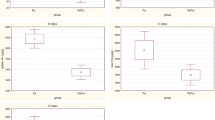Abstract
The level and/or form of dietary iron, dietary nickel, and the interaction between them affected the trace element content of rat liver. Livers were from the offspring of dams fed diets containing 10–16 ng, or 20 μg, of nickel/g. Dietary iron was supplied as ferric chloride (30 μg/g) or ferric sulfate (30 μg, or 60 μg). In nickel-deprived rats fed 60 μg of iron/g of diet as ferric sulfate, at age 35 days, levels of iron and zinc were depressed in liver and the level of copper was elevated. At age 55 days, iron was still depressed, copper was still elevated, but zinc also was elevated. In rats fed 30 μg of iron/g of diet as ferric chloride, liver iron content was higher in nickel-deprived than in nickel-supplemented rats at 30, but not at 50, days of age. Also manganese and zinc were lower in nickel-deprived than in nickel-supplemented rats at age 35 days if their dams had been on experiment for an extended period of time (i.e., since age 21 days). Thus, the levels of copper, iron, manganese, and zinc in liver were affected by nickel deprivation, but the direction and extent of the affects depended upon the iron status of the rat.
Similar content being viewed by others
References
M. Anke, M. Grün, G. Dittrich, B. Groppel, and A. Hennig, inTrace Element Metabolism in Animals-2 (W. G. Hoekstra, J. W. Suttie, H. E. Ganther, and W. Mertz, eds.), University Park Press, Baltimore, pp. 715–718 (1974).
A. Schnegg, and M. Kirchgessner,Arch. Tierernährung 26, 543 (1976).
A. Schnegg, and M. Kirchgessner,Internat. Z. Vit. Ern. Forschung 46, 96 (1976).
A. Schnegg, and M. Kirchgessner, inTrace Element Metabolism in Man and Animals-3 (M. Kirchgessner, ed.), Technical University of Munich, Freising-Weihenstephan, pp. 236–243 (1978).
J. W. Spears, E. E. Hatfield, and R. M. Forbes,Fed. Proc. 37, 404 (1978).
F. H. Nielsen, T. J. Zimmerman, M. E. Collings, and D. R. Myron,J. Nutr. 109, 1623 (1979).
F. H. Nielsen, D. R. Myron, S. H. Givand, T. J. Zimmerman, and D. A. Ollerich:J. Nutr. 105, 1620 (1975).
Analytical Methods for Atomic Absorption Spectrophotometry, Perkin-Elmer Corp., Norwalk, CT (1976).
F. H. Nielsen, T. R. Shuler, T. J. Zimmerman, M. E. Collings, and E. O. Uthus,Biol. Trace Element Research, accepted for publication (1979).
H. SchefféThe Analysis of Variance, Wiley, New York, p. 90 (1959).
F. H. Nielsen, D. R. Myron, S. H. Givand, and D. A. Ollerich,J. Nutr. 195, 1607 (1975).
Author information
Authors and Affiliations
Rights and permissions
About this article
Cite this article
Nielsen, F.H., Shuler, T.R. Effect of dietary nickel and iron on the trace element content of rat liver. Biol Trace Elem Res 1, 337–346 (1979). https://doi.org/10.1007/BF02778835
Received:
Accepted:
Issue Date:
DOI: https://doi.org/10.1007/BF02778835




